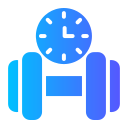Space-Saving Gear That Multiplies Options
A medium band with a secure door anchor delivers rows, presses, face pulls, split squats, and chops. Step farther from the anchor to increase tension. Bands pack light, progress smoothly, and turn any doorway into a multi-station, full-body training setup.
Space-Saving Gear That Multiplies Options
Use a compact suspension trainer or loop two sturdy towels over a closed door. Adjust your body angle to scale difficulty for inverted rows, assisted single-leg squats, and fallouts. Minimal equipment becomes a full-body gym by simply changing incline and stance.




